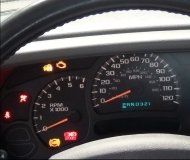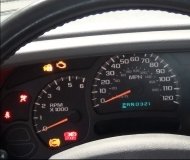Hi and thanks for using 2CarPros.
This can be the result of a few different things. However, I first suspect a fuel pressure issue unless the check engine light is staying on. First, take a look through this link. It discusses the most common causes of an engine to stall at idle, what to check, and how to fix. Also, here is a link that shows how to check fuel pressure:
https://www.2carpros.com/articles/how-to-check-fuel-system-pressure-and-regulator
and
https://www.2carpros.com/articles/stall-at-idle
If that doesn't help, I suggest scanning the computer to see if there are any diagnostic trouble codes stored in the system. Here is a quick video showing how it is done:
https://youtu.be/YV3TRZwer8k
I realize most people don't own a scanner, but often times a parts store will lend or rent one to you.
Next, a bad crankshaft position can act this way, too. Take a look through this link. It discusses common symptoms and the second link shows in general how one is replaced.
https://www.2carpros.com/articles/symptoms-of-a-bad-crankshaft-sensor
https://www.2carpros.com/articles/crankshaft-angle-sensor-replacement
__________________________________________
Here are specific directions for replacing the crankshaft position sensor on your vehicle. The attached pictures correlate with these directions.
CRANKSHAFT POSITION SENSOR REPLACEMENT
picture 1
picture 2
picture 3
IMPORTANT: The CKP System System Variation Learning Procedure will need to be performed whenever the Crankshaft Position (CKP) sensor is removed or replaced. Refer to CKP System Variation Learn Procedure.
REMOVAL PROCEDURE
1. Remove the electrical connector.
2. Remove the sensor hold down bolt.
3. Remove the sensor from the timing cover.
NOTE: When installing or removing a crankshaft position (CKP) sensor make sure the sensor is fully seated and held stationary in the front cover before torquing the hold down bolt into the front cover. A sensor which is not seated may result in erratic operation and lead to the setting of false codes.
4. Inspect the sensor O-ring for wear, cracks or leakage. Replace if necessary. Lube the new O-ring with clean engine oil before installing.
INSTALLATION PROCEDURE
NOTE: Make certain that the Crankshaft Position (CKP) sensor mounting surfaces are clean and free of burrs before installing the CKP sensor.
1. Install the sensor into the timing cover.
2. Install the sensor hold down bolt.
Tighten
Tighten the hold down bolt to 8 Nm (71 lb in).
3. Install the electrical connector.
4. Perform the CKP System Variation Learn Procedure. Refer to CKP System Variation Learn Procedure.
____________________________
Crankshaft Position System Variation Learn
1. Install the scan tool.
2. Apply the vehicle's parking brake.
3. Block the drive wheels.
4. Close the hood.
5. Place the vehicle's transmission in Park (AT) or Neutral (MT).
6. Idle the engine until the coolant temperature reaches 65 C (150 F).
7. Turn OFF all the accessories.
Important:If the CKP System Variation Learn Procedure cannot be completed successfully, refer to DTC P1336 Crankshaft Position (CKP) System Variation Not Learned for additional diagnostic information. See: A L L Diagnostic Trouble Codes ( DTC ) > P Code Charts
8. Enable the Crankshaft Position System Variation Learn Procedure with the scan tool.
Important:After the ignition switch is turned to the CRANK position, the VCM must see a change in the state of brake switch (Released to Applied) to run the learn procedure. Also, the service brakes and the parking brake must be held throughout the duration of the learn procedure.
9. Apply and hold the service brakes.
Important:While the learn procedure is in progress, release the throttle immediately when the engine starts to decelerate. The engine control is returned to the operator and the engine will respond to throttle position after the learn procedure is complete.
10. Slowly raise the engine speed to 4,000 RPM.
11. Immediately release the throttle when the engine speed decreases.
12. Turn OFF the ignition for 15 seconds after the learn procedure is completed successfully.
______________________________________________________
If you decide to check the fuel pressure, here are the manufacturer's specs for pressure:
FUEL PRESSURE SPECIFICATIONS
Ignition On, Engine Off .................... 415 - 455 kPa (60 - 66 psi)
For additional fuel pressure testing and specifications, refer to Fuel System Diagnosis. See: Fuel Pressure > Component Tests and General Diagnostics > Fuel System Pressure Test
Let me know if this helps or if you have other questions.
Take care,
Joe
Images (Click to make bigger)
Thursday, February 18th, 2021 AT 12:53 PM
(Merged)








